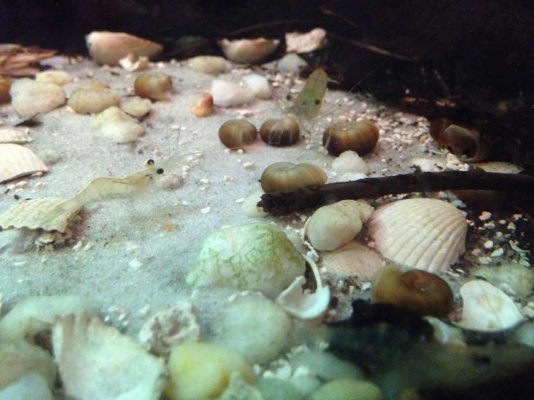Not quite right, sorry to say. There aren't all that many types of shrimp that have this common name. Though I've tried, I've not yet been able to find a species of shrimp that is also called Ghost other than the American native Ghost shrimp, palaemonetes. Also called glass or grass shrimp, and it's possible names of this type might be given to other small shrimp species that are similarly coloured from other countries. I just haven't been able to find any info on them as yet.
Being native to any number of fresh water bodies in the southern USA, the American ghost shrimp does not need brackish water for its larvae to survive. I've raised a dozen broods in fresh water only, to breeding age. The larval stage is short, about 4 days at 70F, before they morph into shrimplets that look like mini adults.
Both of the pics, to me, appear to be palaemonetes, young enough that they don't have any of the adult colouration yet.
Paleamonetes do have variations in terms of markings and general appearance. One description I've read, I think it might have been Wikipedia, said the true species have brilliant orange rings around the 'wrist' on the front pair of legs, with an orange dash on each tail fan. I've had a number of Ghost shrimp that had these bright orange marks, but not all of them show these markings.
Most have black eyes, so far as I've observed in those I've kept. As they grow older their shells will begin to show a number of brownish/black marks while the shell itself will gradually darken as well. The darker colour begins to show first over the back, but eventually covers the entire shell, and is a shade of orange. Shed shells show this orange colour quite distinctly, and don't look white the way younger shrimp's shed shells appear.
Newly morphed shrimp are basically snow white in colour, and remain that way until they get to be at around a half inch long, at which point they being to look more transparent. Young shrimp lack the dark body markings and orange shell colouration, but if they have the orange wrist band and tail dashes, those will be present from birth and visible once they grow large enough so you can see them.
There are a couple of other species of shrimp I have read about here and there that also appear to be be called glass or ghost shrimp, and they may well need brackish water for the larvae to survive. But the North American species is totally fresh water for its whole life cycle.
The bump on the back is common to many, many species. Most of the many different Caridina shrimps have the same sort of bump, but in Ghost shrimp it's quite pronounced, being the most visible feature of newly morphed shrimplets, along with their eyes.




